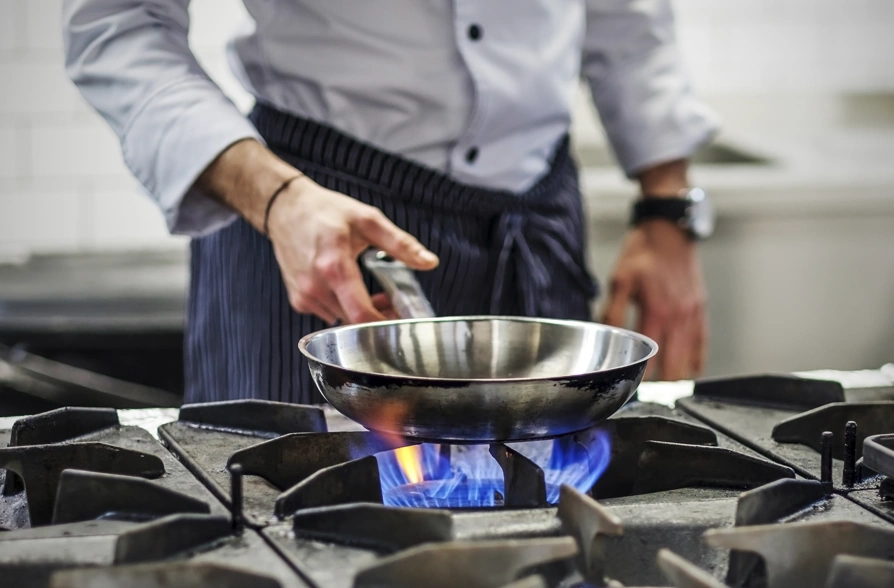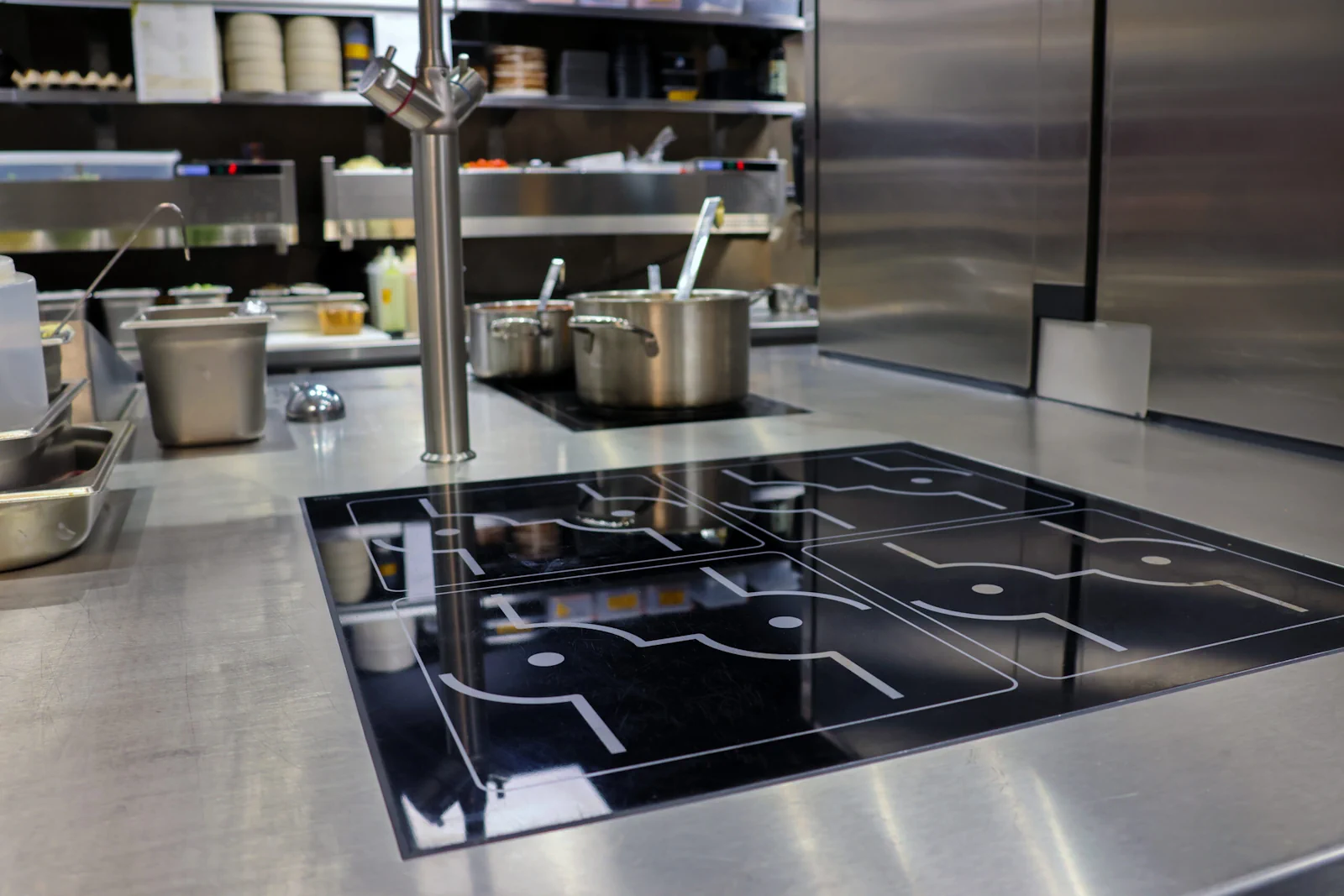In hotel projects we delivered with consultants, designers, and procurement managers, the same debate always appear: gas cooking ranges or induction? Contractors often ask which one make more sense in their BOQ, while kitchen designers think about workflow, and procurement teams focus on operating cost. Some hotels in Africa still swear by gas because of generator limits, while new resorts in Dubai push induction for sustainability and guest perception. From our turnkey projects, both choices are valid — but the right pick depend on capacity, kitchen concept, MEP constraints and service model. Turkish engineering, factory-direct from Istanbul, offer both solutions ready for export. Below we compare them in practical, project-focused terms so you can decide for your hotel kitchen. (And yes, some trade-offs are ugly, but we keep it honest.)
Basic principle: how they work
Gas ranges use open flame or sealed burners with direct thermal transfer. Induction ranges generate heat in the pan via electromagnetic fields — the cooktop stay relatively cool.
Key practical difference
- Gas: instant flame control, visible heat; need gas supply and ventilation.
- Induction: fast heat, precise temperature, safer surface but need compatible pans.
Energy & operating cost — the real numbers that matter
Many clients ask “which is cheaper?” The answer depend on local energy prices and utilization rates.
Typical efficiency comparison (project example)
- Gas burners: 35–45% thermal efficiency (energy lost to air).
- Induction: 80–90% transfer efficiency (less loss).
In resorts in Zanzibar running 24h kitchens, induction reduced energy bills but required generator upgrade. In European retrofits, gas stayed cheaper due to low pipeline tariffs. For a 500-room resort we supported, average monthly cost was $8,000 on gas vs $6,200 on induction, but the CAPEX for electrical upgrade was $90,000 — making ROI depend from local tariffs. In industrial kitchen running continuous production, induction often pay off faster.
Comparison Table: Gas vs Induction
| Criteria | Gas Ranges | Induction Ranges |
| Efficiency | 35–45% | 80–90% |
| CAPEX | Lower initial, high ventilation cost | Higher initial, lower ventilation cost |
| Operating Cost (OPEX) | Higher due to wasted heat | Lower if electricity tariff is favorable |
| Safety | Open flame, higher fire risk | Cool surface, safer for staff |
| MEP Requirements | Gas main, suppression, hood velocity | Heavy electrical load, generator backup |
| Sustainability | On-site combustion, higher CO₂ | Cleaner, align with LEED & green goals |
Capacity & load planning — what BOQ must show
Capacity planning decide equipment counts, line lengths, electrical load or gas manifold sizing.
For large banquet hotels (example)
- High-volume hot lines with heavy pots → gas ranges + stockpots often preferred for brute force heat.
- Central production kitchens with repeatable processes → induction banks offer consistent control and faster recovery.
If your BOQ list 8 × 24kW induction hobs, confirm site electrical supply, power distribution, and panel capacity — contractors often underestimate feeder cable and distribution boxes.
Kitchen workflow & chef preference
Chef skill and culture strongly influence choice.
Workflow impacts
- Gas suit wok-style, open-flame techniques, ethnic cuisine (wok, tandoor adjuncts). Chefs love flame control.
- Induction suit precision cooking (sous-vide finishing, chocolate tempering) and fast line-changeover.
In hotels in Dubai, induction is push as premium. In Turkey-built training kitchens, chefs adapt fast when procurement managers introduce induction step by step.
Safety, ventilation & MEP implications
Switching to induction reduce kitchen ventilation load, grease extraction demand and HVAC load — that can be decisive CAPEX saving.
MEP trade-offs
- Gas: require gas main, alarm, hood velocity, robust suppression.
- Induction: reduce exhaust but raise electrical feeder and backup power considerations. In African resorts with weak grid, mixed fleet (gas + induction) avoid blackout risk.
Fire codes and compliance
European retrofits required strict compliance with EN and CE standards; Dubai projects demanded UL-listed suppression systems; African contractors often used NFPA as reference. Turkey-built hoods with integrated suppression give fast approval in all three regions. MEP consultants must be engage early to avoid redesign.
Maintenance & lifecycle costs
Maintenance patterns differ and influence total cost of ownership.
Typical lifecycle notes
- Gas: periodic burner cleaning, valve servicing, ignition repairs. Easy to source spares.
- Induction: electronic parts, coil replacement in long term, but surface easy to clean.
For 10-year lifecycle models, induction show better TCO in high-utilization kitchens if electricity pricing is stable. Istanbul-manufactured induction ranges exported to Europe showed ROI within 3 years. In one Dubai hotel, induction boards fail early due to poor ventilation design — proving that installation quality matter as much as equipment choice.

Food quality & concept fit
Brand promise and menu concept decide.
Concept examples
- Fine dining: induction precision help consistent plating temps.
- Ethnic cuisine: gas flame (woks, tandoor) deliver authentic flavor.
- Buffet/banquet: mixed lines often best — gas for stockpots, induction for plating.
Installation & footprint considerations
Space and utility footprint differ.
Footprint trade-offs
- Gas lines need safe routing and ventilation clearances.
- Induction need electrical distribution, larger trays, sub-panels.
In European city retrofits, electrical upgrades made induction too costly, so gas remain. In Dubai resorts, induction gain preference due to HVAC savings.
Sustainability & energy strategy
If sustainability or LEED credits are target, induction reduce emissions and improve thermal comfort.
Renewable synergy
Induction pair well with solar + battery for partial load shaving. Turkish engineering teams already integrate these solutions in hotel projects exported globally. Gas still has onsite combustion emissions.
Global trend differences
- Europe: many cities mandate electric kitchens by 2030.
- Middle East: hotels adopt induction for LEED certification and guest perception.
- Africa: mixed fleets remain practical due to generator reliance.
Stat/Trend Reference: By 2030, 40% of European commercial kitchens are projected to be fully electric (source: XYZ industry report). This trend already visible in hotel RFPs across Germany, France, and Scandinavia.
This diversity prove why turnkey planning matter — Turkey-made solutions are flexible enough to match all three contexts.
Practical decision matrix (quick checklist)
Use this checklist when deciding:
- Meals per peak hour (>1000? consider mixed)
- Menu type (wok/ethnic/fine dining)
- Local tariffs (electric vs gas)
- Existing MEP capacity (electrical vs gas main)
- Chef preference & training plan
- Local spare parts availability
- Sustainability goals (net-zero target?)
Real Case Study

❓ FAQ – Gas Cooking Ranges vs Induction Cooking Ranges
Is induction always cheaper to run than gas?
Not always. In Zanzibar resort projects, induction was efficient but generator cost offset savings. In Europe gas stay cheaper with pipeline tariffs.
Can induction replace heavy stockpot cooking?
Some high-power induction units handle stockpots, but very large volumes still use gas stockpots or tilting kettles.
What about backup during power outages?
Induction require generator sizing. Many African hotels keep mixed lines to manage outages.
Do insurance or compliance costs change?
Yes. Some insurers in Europe give lower premiums for fully electric kitchens due to fire risk reduction. In Dubai, compliance with UL suppression is mandatory for gas.
Which system is better for open buffet show-cooking?
Induction is safer and cleaner for FOH buffet lines. Gas may be restrict in open show areas by local code.
